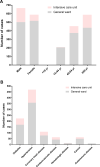Clinical characteristics of 17 patients with COVID-19 and systemic autoimmune diseases: a retrospective study
- PMID: 32546598
- PMCID: PMC7316114
- DOI: 10.1136/annrheumdis-2020-217425
Clinical characteristics of 17 patients with COVID-19 and systemic autoimmune diseases: a retrospective study
Abstract
Objectives: Increasing data about COVID-19 have been acquired from the general population. We aim to further evaluate the clinical characteristics of COVID-19 in patients with systemic autoimmune diseases (AIDs).
Methods: We included all confirmed inpatients with COVID-19 and systemic AIDs in Wuhan Tongji Hospital from 29 January to 8 March 2020. We retrospectively collected and analysed information on epidemiology of 1255 inpatients and additional clinical characteristics of patients with systemic AIDs. Outcomes were followed up until 16 April 2020.
Results: Of the 1255 patients with COVID-19, the median age was 64.0 years and 53.1% were male. More than half (63.0%) had chronic comorbidities. The proportions of elderly, male and patients with comorbidities were significantly higher in intensive care unit (ICU) than in the general ward (p<0.001). 17 (0.61%) patients with systemic AIDs were further screened and analysed from 2804 inpatients. The median age was 64.0 years and 82.4% were female. All patients were living in Wuhan and two family clusters were found. 1 (5.9%) patient was admitted to ICU and one died. 10 (62.5%) of 16 patients changed or stopped their anti-AIDs treatments during hospitalisation, and 5 of them felt that the disease had worsened after the quarantine.
Conclusions: Older males with chronic comorbidities are more vulnerable to severe COVID-19. The lower proportion of COVID-19 in patients with systemic AIDs needs more high-quality human clinical trials and in-depth mechanism researches. Of note, the withdrawal of anti-AIDs treatments during hospitalisation can lead to flares of diseases.
Keywords: autoimmune diseases; epidemiology; glucocorticoids; hydroxychloroquine.
© Author(s) (or their employer(s)) 2020. No commercial re-use. See rights and permissions. Published by BMJ.
Conflict of interest statement
Competing interests: None declared.
Figures


Comment in
-
New data emerging on outcomes for patients with COVID-19 and rheumatic diseases.Nat Rev Rheumatol. 2020 Aug;16(8):407. doi: 10.1038/s41584-020-0463-8. Nat Rev Rheumatol. 2020. PMID: 32620941 Free PMC article. No abstract available.
References
-
- WHO World health organization, 2020.
Publication types
MeSH terms
LinkOut - more resources
Full Text Sources
Medical
Miscellaneous

